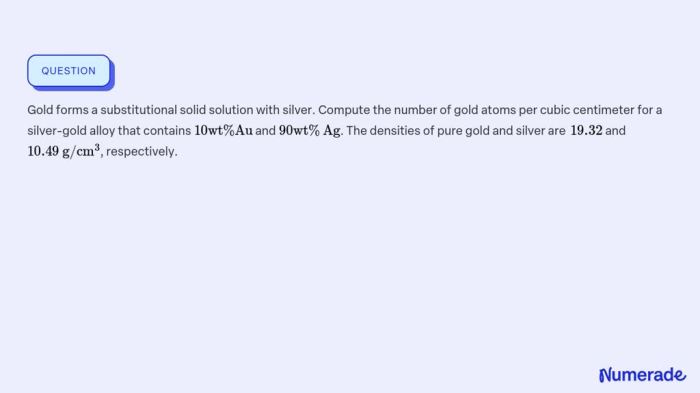Gold forms a substitutional solid solution with silver, a phenomenon that offers unique properties and technological applications. This solid solution is characterized by the replacement of atoms in the crystal lattice of one metal with atoms of another, leading to a homogeneous mixture at the atomic level.
The gold-silver system serves as a prime example of this type of solid solution, providing valuable insights into its formation, properties, and practical applications.
The phase diagram of the gold-silver system reveals the formation of a continuous series of solid solutions, indicating complete solubility between the two metals. This substitutional solid solution exhibits properties that are intermediate between those of pure gold and pure silver, making it a versatile material for various applications.
Properties of Substitutional Solid Solutions

Substitutional solid solutions are formed when atoms of one element replace atoms of another element in a crystal lattice. The atoms that are replaced are typically of similar size and have the same valence. Substitutional solid solutions can have a wide range of properties, depending on the composition of the solution.
Some substitutional solid solutions are very hard and strong, while others are soft and ductile. The properties of substitutional solid solutions are also affected by the temperature and pressure at which they are formed.
Examples of substitutional solid solutions include:
- Brass, which is a substitutional solid solution of copper and zinc
- Steel, which is a substitutional solid solution of iron and carbon
- Bronze, which is a substitutional solid solution of copper and tin
The formation of substitutional solid solutions is affected by a number of factors, including the size of the atoms involved, the electronegativity of the atoms, and the temperature and pressure at which the solution is formed.
Gold-Silver System

The gold-silver system is a classic example of a substitutional solid solution. The phase diagram of the gold-silver system shows that the two metals form a continuous series of solid solutions at all temperatures. This means that any composition of gold and silver can be formed into a single-phase solid solution.
The properties of the gold-silver solid solution vary with the composition of the solution. For example, the hardness of the solution increases with increasing gold content. The electrical conductivity of the solution also increases with increasing gold content.
The gold-silver solid solution is used in a variety of applications, including jewelry, coinage, and dentistry. The solution is also used in electrical contacts and in the manufacture of electronic components.
Applications of Gold-Silver Substitutional Solid Solutions

Gold-silver substitutional solid solutions are used in a variety of applications, including:
- Jewelry: Gold-silver alloys are used to make jewelry because they are strong, durable, and have a beautiful appearance. The composition of the alloy can be varied to change the color of the jewelry.
- Coinage: Gold-silver alloys have been used to make coins for centuries. The alloy is used because it is hard and durable, and it has a high resistance to corrosion.
- Dentistry: Gold-silver alloys are used to make dental fillings and crowns. The alloy is used because it is strong, durable, and biocompatible.
- Electrical contacts: Gold-silver alloys are used to make electrical contacts because they are highly conductive and resistant to corrosion.
- Electronic components: Gold-silver alloys are used to make electronic components because they are highly conductive and have a low coefficient of thermal expansion.
The advantages of using gold-silver substitutional solid solutions in these applications include their strength, durability, and resistance to corrosion. The disadvantages of using gold-silver substitutional solid solutions include their high cost and their tendency to tarnish.
Comparison with Other Solid Solutions

Gold-silver substitutional solid solutions are similar to other types of solid solutions, such as interstitial and intermetallic solid solutions. However, there are some key differences between these types of solid solutions.
Interstitial solid solutions are formed when atoms of one element occupy the interstitial sites in the crystal lattice of another element. Interstitial solid solutions are typically formed between small atoms and large atoms. The properties of interstitial solid solutions are typically similar to the properties of the pure metal.
However, the hardness and strength of interstitial solid solutions can be increased by the presence of the interstitial atoms.
Intermetallic solid solutions are formed when atoms of two different elements combine to form a new compound. Intermetallic solid solutions typically have a different crystal structure than the pure metals. The properties of intermetallic solid solutions can be very different from the properties of the pure metals.
Intermetallic solid solutions can be very hard and strong, but they can also be brittle.
The table below compares the properties of gold-silver substitutional solid solutions, interstitial solid solutions, and intermetallic solid solutions.
| Property | Gold-silver substitutional solid solutions | Interstitial solid solutions | Intermetallic solid solutions |
|---|---|---|---|
| Crystal structure | Same as pure metals | Same as pure metals | Different from pure metals |
| Properties | Similar to pure metals | Similar to pure metals, but can be harder and stronger | Very different from pure metals, can be hard and strong, but also brittle |
Query Resolution: Gold Forms A Substitutional Solid Solution With Silver
What are the key characteristics of substitutional solid solutions?
Substitutional solid solutions are characterized by the replacement of atoms in the crystal lattice of one metal with atoms of another, resulting in a homogeneous mixture at the atomic level.
How does the gold-silver system demonstrate the formation of a substitutional solid solution?
The phase diagram of the gold-silver system shows a continuous series of solid solutions, indicating complete solubility between the two metals, leading to the formation of a substitutional solid solution.
What are the potential applications of gold-silver substitutional solid solutions?
Gold-silver substitutional solid solutions find applications in electronics, catalysis, jewelry, and other fields due to their tunable properties, such as electrical conductivity, mechanical strength, and optical characteristics.